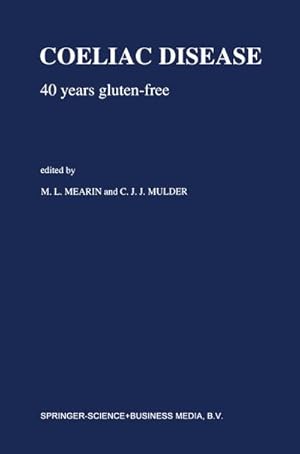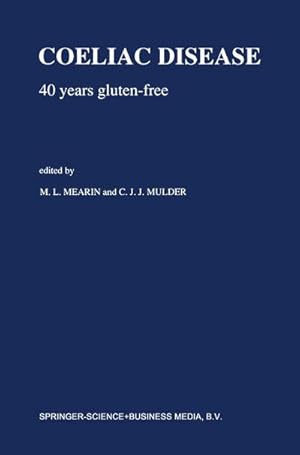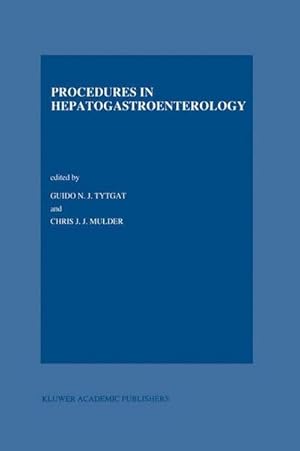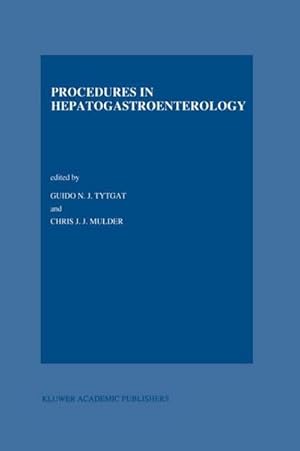mulder chr j (5 Ergebnisse)
Produktart
- Alle Product Types
- Bücher (5)
- Magazine & Zeitschriften
- Comics
- Noten
- Kunst, Grafik & Poster
- Fotografien
- Karten
- Manuskripte & Papierantiquitäten
Zustand
Einband
Weitere Eigenschaften
- Erstausgabe
- Signiert
- Schutzumschlag
- Angebotsfoto (4)
Gratisversand
- Versand nach USA gratis
Land des Verkäufers
Verkäuferbewertung
-
Oudtestamentliche Studien, Deel XV: The Priestly Code and Seven Other Studies
Verlag: E.J. Brill, 1969
Hardcover, no dust jacket. Ex-library, light edge-wear to boards, otherwise very good. 250 pages. 250 pp.
-
Coeliac Disease : 40 years gluten-free
Verlag: Springer Netherlands, 1991
ISBN 10: 0792311604ISBN 13: 9780792311607
Anbieter: AHA-BUCH GmbH, Einbeck, Deutschland
Buch
Buch. Zustand: Neu. Druck auf Anfrage Neuware - Printed after ordering - InhaltsangabeHistory of coeliac disease. Dicke and the origin of the gluten-free diet.- HLA and coeliac disease, a finnish family study.- Adenovirus 12 and coeliac disease.- Gliadin peptides: their effect on the gut mucosa.- HLA-DR-DP and -DQ antigens in coeliac disease.- A cis- or transassociated DQ heterodimer predisposes to the gluten sensitive enteropathy seen in coeliac disease and dermatitis herpetiformis.- Nonhuman primates as animal models for coeliac disease: approach and feasibility.- T-cell subpopulations in intestinal mucosa.- Persistent increase of intra-epithelial T-cell receptor cells in coeliac disease.- T-cell subpopulations in coeliac disease; longterm follow up with a gluten containing diet.- Intraepithelial T-cells of the TcR / +CD8- and V 1+ phenotypes are strikingly increased in coeliac disease.- Intestinalg amma/delta receptor bearing T lymphocytes are increased in coeliac disease and dermatitis herpetiformis.- Detecting gluten and related prolamins in food.- Gluten-free products, the Dutch experience.- The quest for gliadin; limits and tolerance.- The incidence of coeliac disease and changes in gluten consumption.- Cath-up growth in 60 children with coeliac disease.- Clinical features of adult coeliac disease in Italy.- Associated diseases in children with coeliac disease.- Coeliac disease and autoimmune enteropathy.- Coeliac disease, malignancy and the effect of gluten free diet.- Dermatitis Herpetiformis: coeliac disease of the skin.- Latent coeliac disease.- Small intestinal biopsy.- High incidence of atypical forms of coeliac disease in a pediatric case study.- Coeliac disease in The Netherlands.- IGA reticulin antibody binding to human jejunum in sera of children with coeliac disease: the possible autoantibody of gluten sensitive enteropathy.- Evidence for a dominant gene mechanism in coeliac disease.- Crypt intraepithelial lymphocytes number is a sensitive index of dietary compliance in teenager coeliacs.- Upper G.I. damages seen at endoscopy in children with coeliac disease.- HLA class II contribution to coeliac disease -a family study-.- Diabetes-related immunologic markers in children coeliac disease.- HLA antigens and phenotypes associated with severe immunoglobulin - a deficiency in coeliac disease paediatric patients.- DR3 and DR7 -negative coeliac disease- a clinically relevant entity .- Intestinal expression of HLA-DQ alleles associated to coeliac disease.- Is persistent adenovirus 12 (Ad12) infection involved in coeliac disease .- Negative humoral response to adenovirus 12 in coeliac disease.- Characterization of TCR in T cell clones from small intestine of coeliac disease patients.- Characterization of intestinal and T-cell receptor positive cells in coeliac disease.- Intercellular adhesion molecule-1 expression in coeliac disease.- Coeliac disease in Cyprus.- Coeliac disease in saudi children.- The spectrum of gluten intolerance in a defined paediatric population.- The reasons of malnutrition in children with coeliac disease.- Nervous system involvement in paediatric coeliac patients.- Coeliac disease and epilepsy with posterior cerebral calcifications: a causal association.- Genetic and immunological markers in children with dermatitis herpetiformis.- The clinical use of the gliadin antibody test.- Serum antigliadin antibodies during gluten challenge.- IgG-subclass antibodies to food antigens in patients with coeliac disease.- Isolation and characterization of wheat proteins with antibody reactivity against serum of a patient with coeliac disease.- Specific IgA-gliadin antibody as a marker of relapse in coeliac children on gluten challenge.- Gluten and dermatitis herpetiformis; clinical observations in 5 active DH patients on an elemental diet.- Serum transglutaminase in the follow-up of coeliac disease.- Methods for measurement of gluten in foodstuffs.- Identification of coeliac-active peptides using a novel in vitro test for cellular immunity.- Unresponsive subtotal villous atrophy.
-
Coeliac Disease : 40 years gluten-free
Verlag: Springer Netherlands, 2010
ISBN 10: 9048140870ISBN 13: 9789048140879
Anbieter: AHA-BUCH GmbH, Einbeck, Deutschland
Buch
Taschenbuch. Zustand: Neu. Druck auf Anfrage Neuware - Printed after ordering - InhaltsangabeHistory of coeliac disease. Dicke and the origin of the gluten-free diet.- HLA and coeliac disease, a finnish family study.- Adenovirus 12 and coeliac disease.- Gliadin peptides: their effect on the gut mucosa.- HLA-DR-DP and -DQ antigens in coeliac disease.- A cis- or transassociated DQ heterodimer predisposes to the gluten sensitive enteropathy seen in coeliac disease and dermatitis herpetiformis.- Nonhuman primates as animal models for coeliac disease: approach and feasibility.- T-cell subpopulations in intestinal mucosa.- Persistent increase of intra-epithelial T-cell receptor cells in coeliac disease.- T-cell subpopulations in coeliac disease; longterm follow up with a gluten containing diet.- Intraepithelial T-cells of the TcR / +CD8- and V 1+ phenotypes are strikingly increased in coeliac disease.- Intestinalg amma/delta receptor bearing T lymphocytes are increased in coeliac disease and dermatitis herpetiformis.- Detecting gluten and related prolamins in food.- Gluten-free products, the Dutch experience.- The quest for gliadin; limits and tolerance.- The incidence of coeliac disease and changes in gluten consumption.- Cath-up growth in 60 children with coeliac disease.- Clinical features of adult coeliac disease in Italy.- Associated diseases in children with coeliac disease.- Coeliac disease and autoimmune enteropathy.- Coeliac disease, malignancy and the effect of gluten free diet.- Dermatitis Herpetiformis: coeliac disease of the skin.- Latent coeliac disease.- Small intestinal biopsy.- High incidence of atypical forms of coeliac disease in a pediatric case study.- Coeliac disease in The Netherlands.- IGA reticulin antibody binding to human jejunum in sera of children with coeliac disease: the possible autoantibody of gluten sensitive enteropathy.- Evidence for a dominant gene mechanism in coeliac disease.- Crypt intraepithelial lymphocytes number is a sensitive index of dietary compliance in teenager coeliacs.- Upper G.I. damages seen at endoscopy in children with coeliac disease.- HLA class II contribution to coeliac disease -a family study-.- Diabetes-related immunologic markers in children coeliac disease.- HLA antigens and phenotypes associated with severe immunoglobulin - a deficiency in coeliac disease paediatric patients.- DR3 and DR7 -negative coeliac disease- a clinically relevant entity .- Intestinal expression of HLA-DQ alleles associated to coeliac disease.- Is persistent adenovirus 12 (Ad12) infection involved in coeliac disease .- Negative humoral response to adenovirus 12 in coeliac disease.- Characterization of TCR in T cell clones from small intestine of coeliac disease patients.- Characterization of intestinal and T-cell receptor positive cells in coeliac disease.- Intercellular adhesion molecule-1 expression in coeliac disease.- Coeliac disease in Cyprus.- Coeliac disease in saudi children.- The spectrum of gluten intolerance in a defined paediatric population.- The reasons of malnutrition in children with coeliac disease.- Nervous system involvement in paediatric coeliac patients.- Coeliac disease and epilepsy with posterior cerebral calcifications: a causal association.- Genetic and immunological markers in children with dermatitis herpetiformis.- The clinical use of the gliadin antibody test.- Serum antigliadin antibodies during gluten challenge.- IgG-subclass antibodies to food antigens in patients with coeliac disease.- Isolation and characterization of wheat proteins with antibody reactivity against serum of a patient with coeliac disease.- Specific IgA-gliadin antibody as a marker of relapse in coeliac children on gluten challenge.- Gluten and dermatitis herpetiformis; clinical observations in 5 active DH patients on an elemental diet.- Serum transglutaminase in the follow-up of coeliac disease.- Methods for measurement of gluten in foodstuffs.- Identification of coeliac-active peptides using a novel in vitro test for cellular immunity.- Unresponsive subtotal villous atrophy.
-
Procedures in Hepatogastroenterology
Verlag: Springer Netherlands, 2012
ISBN 10: 9401064881ISBN 13: 9789401064880
Anbieter: AHA-BUCH GmbH, Einbeck, Deutschland
Buch
Taschenbuch. Zustand: Neu. Druck auf Anfrage Neuware - Printed after ordering - Endoscopy has revolutionized clinical gastroenterology. In 1961 Basil Hirschowitz published the first flexible endoscopic examination of the stomach and duodenal bulb. We moved from flexible fiberendoscopes to current video-endoscopic equip ment. Current video-endoscopes incorporate a black and white or color 'chip' at the tip of the instrument which transforms the visual image into electronic signals. The size of the pincet is constantly getting smaller, heading for 5 /Lm, further increasing the resolution. The signals are reassembled into high-quality color images in a video monitor. Endoscopes are now used to examine the entire gastrointestinal tract from esophagus to rectum, including the biliary and pancreatic ductal system. Targeted endoscopic biopsy offers rapid and precise diagnosis. Endoscopic ultrasonography is of unsurpassed accuracy in staging gastrointestinal tumors, in assessing pancreatic and biliary disease, and disorders of the rectum and anal canal. Moreover, targeted cytological sampling is possible of abnormalities of the intestinal wall or peri intestinal lymph node. Yet despite these glamorous achievements changes are to be expected in the overall emphasis of diagnostic endoscopy. Magnetic resonance cholangiopancreatography may very well compete for a substantial fraction of diagnostic ERCP. Virtual colonoscopy or computed tomographic colography may well compete with (and take over ) screening/surveillance colonoscopy.
-
Procedures in Hepatogastroenterology
Verlag: Springer Netherlands, 1997
ISBN 10: 0792343522ISBN 13: 9780792343523
Anbieter: AHA-BUCH GmbH, Einbeck, Deutschland
Buch
Buch. Zustand: Neu. Druck auf Anfrage Neuware - Printed after ordering - Endoscopy has revolutionized clinical gastroenterology. In 1961 Basil Hirschowitz published the first flexible endoscopic examination of the stomach and duodenal bulb. We moved from flexible fiberendoscopes to current video-endoscopic equip ment. Current video-endoscopes incorporate a black and white or color 'chip' at the tip of the instrument which transforms the visual image into electronic signals. The size of the pincet is constantly getting smaller, heading for 5 /Lm, further increasing the resolution. The signals are reassembled into high-quality color images in a video monitor. Endoscopes are now used to examine the entire gastrointestinal tract from esophagus to rectum, including the biliary and pancreatic ductal system. Targeted endoscopic biopsy offers rapid and precise diagnosis. Endoscopic ultrasonography is of unsurpassed accuracy in staging gastrointestinal tumors, in assessing pancreatic and biliary disease, and disorders of the rectum and anal canal. Moreover, targeted cytological sampling is possible of abnormalities of the intestinal wall or peri intestinal lymph node. Yet despite these glamorous achievements changes are to be expected in the overall emphasis of diagnostic endoscopy. Magnetic resonance cholangiopancreatography may very well compete for a substantial fraction of diagnostic ERCP. Virtual colonoscopy or computed tomographic colography may well compete with (and take over ) screening/surveillance colonoscopy.






